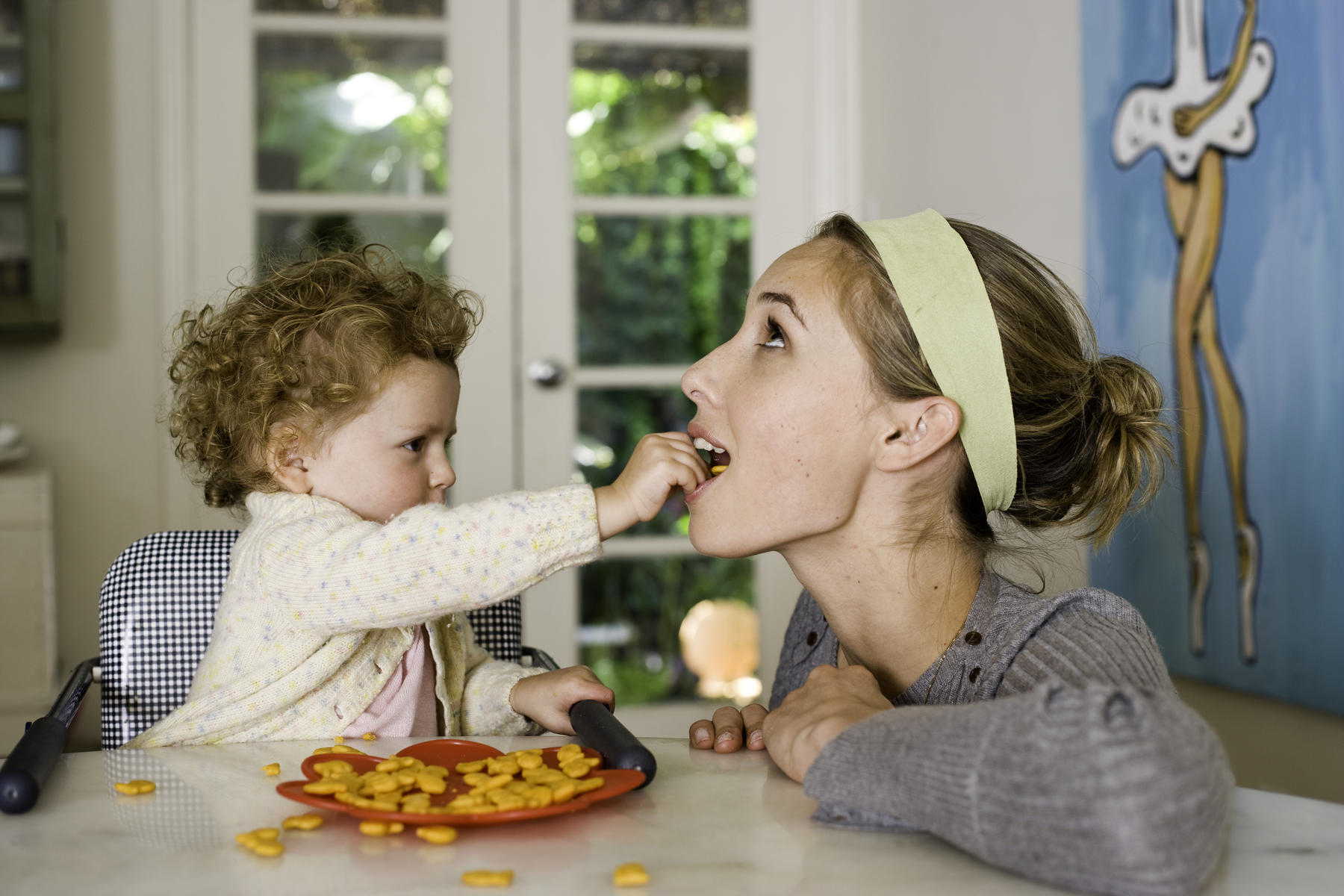
Ever watch a toddler inspect her mac 'n' cheese with archaeologist-like scrutiny before slowly and deliberately eating it, noodle by noodle? Or give a fork the cold shoulder as you try to coerce her to eat one more bite of peaches? Then you know: Kids are mindful eaters. They don't plop down on the couch with a pint of mint chip after a tough day at the playground or stand in front of the fridge, absently polishing off the leftover pad Thai. But we do. Beginning close to age 3, we start to lose the innocence of eating when hungry and stopping when our stomach feels full, explains Susan Albers, Psy.D., a psychologist at the Cleveland Clinic Family Health & Surgery Centers and author of Mindful Eating 101.
Our snacking and meal choices become more influenced by our environment, and soon we're picking dinners based on how they soothe our emotions or what TV pitchmen promise us, making it more challenging to lose the baby weight. (Regardless of when you had your baby, if you're reading Parents, we say it's still baby weight!) Fortunately, there's a better role model for us, who happens to be right under our nose: our toddlers.
1. They're Seated for Meals.
Little kids often don't have a choice in the matter—they eat buckled into a high chair. "The good news is that it teaches them to stay still while they eat, which is a challenge for many adults," Dr. Albers says. Unlike standing, sitting promotes concentration, which allows you to accurately keep tabs on portion sizes. One study found that when people ate lunch while seated at a table, they consumed a third less of an afternoon snack than those who devoured their midday meal while standing at a counter.
KID-INSPIRED TIP You don't have to strap yourself into a booster seat to monitor your eats: Just park yourself at the table rather than spooning cereal as you apply mascara in the morning. "We make irrational decisions when we eat standing up," says Lisa Dorfman, R.D., author of Legally Lean. "Hovering in front of the pantry and snacking from a bag of chips feels quite different from actually sitting down with them." Dorfman points out: "Physiologically, it's easier to stop because you feel your waistband tightening against you, a sensation that disappears when standing."
2. They Say No.
When toddlers are full, they push away their plate—sometimes literally sending it flying over the edge of the table. But adults, even when they are Thanksgiving-dinner stuffed, often continue to nibble out of boredom, to avoid "wasting" food, or just because it's there.
KID-INSPIRED TIP Put your fork down between bites and ask yourself as you chew, "Am I satisfied or am I still hungry?" As you approach "full" mode, move your meal out of reach or ask the waiter to remove it. Resist eating food mindlessly from your kids' plates (what mom really wants a hot dog or a PB & J anyway?). "It's better to throw it away than to eat all those extra calories," Dr. Albers says. If you can't bring yourself to do that because you're a card-carrying member of the Clean Plate Club, switch to smaller dishes: You can fill them up—and clean 'em off—with significantly less food and for fewer calories, respectively.
3. They Don't Multitask.
When it comes to mealtime, kids don't have a "to do" list to run through while they eat. Moms, however, might quickly down a sandwich while simultaneously unloading the dishwasher and staying on hold with the electric company. "You can get into trouble by talking on the phone or making your kid's lunch while you're having your own, which distracts you from your body's fullness cues," notes Parents advisor Jenn Berman, Psy.D., a family therapist in Beverly Hills, California. "If you're paying attention to what's on the Internet or TV while you're eating, you're not in tune with how full you are."
KID-INSPIRED TIP Don't eat in front of a screen. A study in the journal Appetite found that women who watched TV while dining gobbled significantly more cookies when snacking later than those who ate sans television. Lunching at work? Try to escape your desk so you're not tempted to nosh while poking around online.
4. They Taste Their Food.
Toddlers have a fresh, discerning palate. Their taste buds haven't yet been corrupted by the massive amounts of sugar and sodium in today's foods, so if they take a bite of something too sweet or too salty, they clamp up. (In the same way, once they find something they do like to eat they become obsessed, leading to Broccoli Six Nights a Week Syndrome.) Adults are less discriminating, however: We'll munch on cold, soggy French fries or wait in line for free Costco samples when we're not hungry, and we don't even notice when our plate of pasta has a small salt-shaker's worth of sodium. "Often, women eat mediocre food simply because it's easily available, low-fat, or free," says Dr. Albers. "Eating has become a chore, like brushing your teeth. We've lost the art of savoring food."
KID-INSPIRED TIP Give yourself the opportunity to truly taste your meal by practicing mindful eating. Try this trick: Grab an orange and sit in a quiet space with no distractions. Peel the orange and separate it into slices, just as you would for your little one. Experience it the way she would, perhaps as if for the first time: Breathe in its citrusy zest as you close your eyes and take a bite. Pay attention to the juiciness of the fruit; focus on the flavors as they burst in your mouth. Bringing all of your senses into play intensifies the taste of what you're eating, and research shows that mindful eaters tend to consume fewer calories and less fat overall. They also feel more capable about accomplishing their weight-loss goals.
5. They Don't Dig a Spoon Into a Pint of Ice Cream.
And they don't bring cartons of takeout to the couch. Of course, you wouldn't let them. You fill their snack catcher with a serving of cereal or serve up a grilled cheese and some apple slices. But adults have a bad habit of cozying up to XL servings on the sofa or bringing serving platters and bowls to the table rather than pre-serving in the kitchen. This often leads to over-consumption.
KID-INSPIRED TIP Dish out one plate for yourself just as you'd prepare a plate for your toddler, then leave the trays and pans behind before sitting down to eat. Feel free to break this rule when it comes to fruit, vegetables, or salad.

